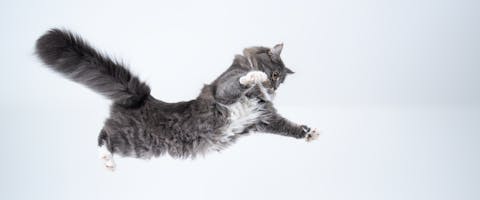Cat physics has baffled cat carers and scientists alike since they first allowed us humans to domesticate them around 10,000 years ago. Most of us have at least seen videos of felines falling from crazy heights only to delicately land on their feet. How!? How do cats always land on their feet and which magical realm do they dwell in?
In all seriousness, the question of why cats always land on their feet is an important one for all pet parents to ask. By understanding cat reflexes, how high cats can fall without hurting themselves, and their innate ability to defy the laws of physics, we can better learn how to protect and care for them.
Let’s prime our cat-like reflexes and pounce into everything you need to know about whether cats do always land on their feet…
Trending posts
Purr-use some of the top blogs our members have been loving this month- Top male dog names for your new furry friendGot a new furry family member in your pack? Check…

- Top female dog names for your new fluffy palWelcoming a new pooch into your family? Explore…

- 250+ gray cat names your silver feline will loveRecently welcomed a fluffy gray bundle of joy into…

- What are normal pet sitting rates?Discover the average pet sitting rates for animals…

- Unique dog names to stand out from the packDare to be different with our list of the best…

Do cats always land on their feet?
The short answer is, that they almost always will land on their feet. Almost. Of course, every falling feline’s situation is different and their age and weight will affect how quickly they react. However, it’s an inbuilt instinct that all kitties are born with.
Want to know something strange? Cats are more likely to injure themselves from a shorter fall than a longer fall. Yeah! To summarize some complex math and science, the further a cat has to fall the more time it has to right itself. With the combination of air resistance versus gravity, cat terminal velocity (maximum cat falling speed) will level out at about 60mph.
When falling from a short distance, a cat doesn’t have enough time to right itself and will often remain rigid. This is where sprains and breaks can occur in their paws and legs.
Cats break physics every time they jump or fall, and we lesser humans will never be able to understand their sophisticated ways of life. But we all knew that anyway!
How do cats always land on their feet?
How do cats defy the laws of physics? A question that was not answered by science until 1894! Yep, it took scientists millennia to solve this mega mystery. It was all thanks to a famous French biologist Étienne-Jules Marey and his new-fangled camera. He used something called a chronographic camera - which, at the time, was the height (pun intended) of cutting-edge technology - that was able to capture multiple images in one second. In this case, his camera was able to take 60 frames a second of a cat falling.
But what exactly did Marey discover? He was able to witness cat reflexes at their best. A falling feline will use its flexible backbone to allow its body to rotate so it descends front paws first and prepares itself mid-flight to land safely. We’ll be honest, there’s a huge amount of science around this, with words like angular momentum and vestibular apparatus being thrown around. For those looking for the fully furry facts, American Scientific has a great article describing the mechanics of cat physics.
For pet parents, it means that cats are instinctively born to ‘right themselves’ when they fall. However! And this is important - this will completely depend on the height of the fall. This might be weird to read, but cats can injure themselves from tumbling off something as low as one meter off the ground. This can include rolling off a window ledge whilst sleeping or suddenly slipping from a countertop.
Why do cats always land on their feet?
The simple answer is instinct. Although they’ve been our lap companions for thousands of years, our feline friends still have most of their wild brain instincts. Back before cats decided they were going to live with us, they would spend their days hunting in dense jungles, using trees to scope out prey and danger. Being able to climb huge heights without thumbs means falling is an occupational hazard. So, having cat reflexes that can save them after a slip has allowed this instinct to evolve.
It’s quite literally cat crazy! Our cute mini-mowers are more resilient than they let on. Although, they still deserve a healthy dose of pampering each day, just saying!
When should I contact my vet?
If you’ve seen your cat fall or jump from a significant height, you need to contact your vet straight away. Cats being cats, they are very good at masking pain so it may not be obvious at first if they’ve hurt themselves. If you’re ever uncertain what to do, always call your vet clinic and ask for advice. Our feline friends are very resilient, but it’s always better to be overly cautious.
For cats who have jumped or landed and look like they are injured, take them to an emergency vet straight away. Similarly, if your cat starts to behave differently after a fall, you must also contact your vet immediately. Never leave anything to chance.
TrustedHousesitters members can contact our 24/7 Vet Advice line if they’re ever worried about their cat or the furry friend you’re pet sitting. If you’re not a member yet, check out the latest list of caring cat sitters near you who waiting and ready to befriend your favorite feline.

